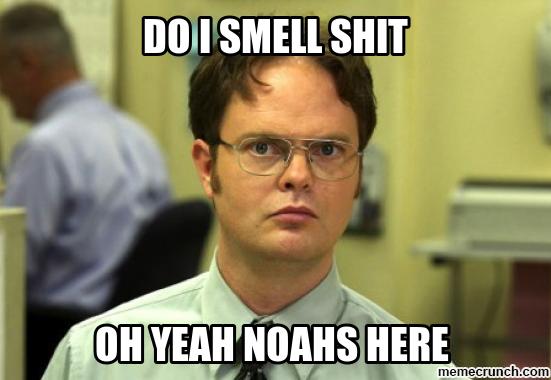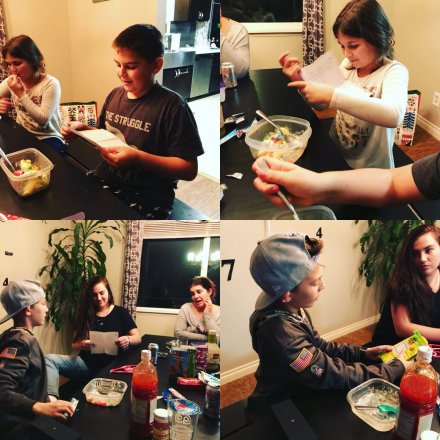Originally published as Lessons from Noah on Vision and Endurance, February 3, 2017 in The Daily Positive.
By Jon Isaacson
Whether you believe the account of Noah and his giant wooden boat is a historical record or just a nice story, the general narrative is one that most people, including entrepreneurs and business leaders, are familiar. There is a catastrophic flood on the horizon, and Noah is told by God to build an ark.

Need an ark? I Noah a guy…
Our main character heeds the booming voice of heaven and, in doing so, saves himself, his family, and the representatives of the animal kingdom that will repopulate the land after the flood cleanses the earth. The story told in the Old Testament chapters of Genesis 6-9 continues to receive some public acclaim with the recent opening of the life-sized Ark Encounter in Kentucky as well as many lesser-known attractions such as the Noah’s Ark Biblical History Museum in Winston, Oregon.
The story of Noah and the flood has been retold through several Hollywood iterations both in the comedic form with Steve Carell in the reluctant modern-day version in Evan Almighty as well as in the very dramatic form with Russell Crowe at the helm of the massive floating wood structure in the picture titled “Noah”.
In our modern society fear is not hard to find, whether it’s a new calendar year, the opening of a financial quarter, or even an average day on social media, countless pundits proclaim the next catastrophe that will cripple our global economies.
If there is trouble on the horizon, perhaps we can learn something from the archetype of a man who was calm under pressure and followed through with his convictions to create a positive legacy with a global reach. Individuals and scientific groups continue to search for the physical location and remnants of the wooden structure, perhaps in part searching for confirmation that we can survive the worst of what nature can throw at us.
The Noah narrative may prove helpful to the aspiring entrepreneur as well as the modern leader navigating the troubled waters of managing with vision, maintaining the elusive work-life balance and living a life of purpose.
What lessons might we learn from Noah as a visionary leader and innovator?
1. Your work should be motivated by vision.
Your work should be motivated by a vision so that you can work tirelessly in the face of opposition. If you can see further down the road than most entrepreneurs, people will likely think your efforts are crazy. If people think you are crazy, they are either right, or you may be moving in the right direction!
Most entrepreneurial success stories include accounts of all the detractors who stood on the sidelines mocking the entrepreneur’s efforts. Star athletes are often motivated by someone in their past who didn’t think they were good enough. A chip on the shoulder seems to be a consistent motivator for success in the lives of those who are visionaries and game changers.
Noah was building the biggest boat known to man during a period of drought, at the time there was nothing more nonsensical than the work of Noah and his family. Pounding nails day after day can become a menial task, but when those nails bring an individual closer to his goal, the mechanics become a work of art, the thud of the hammer a soundtrack, and the small evidence of progress perpetuates the effort forward.
“VISION WITHOUT ACTION IS MERELY A DREAM. ACTION WITHOUT VISION JUST PASSES THE TIME. VISION WITH ACTION CAN CHANGE THE WORLD.” – JOEL A. BARKER
2. Your work should include, or at least not exclude, your family.
While Millennials get a bad rap for “not being motivated,” what many fail to understand is that Generation X and Y grew up with the consequences of a society putting work above all else. What happens when the dust settles on a career, and the family has played second fiddle? The employee who was loyal to his company but no longer serves a purpose has neither company nor family in the end. Good organizations and intelligent employees understand that their personal, family, and professional lives all need investments of time to thrive.
While many claim to work themselves for the good of their family, the one resource that none of us can get back is time. Noah included his family in his work, whether that was willing labor or not, in the end, the work kept them alive and literally brought them together. Time is limited, so it must be spent with purpose.
“THERE’S NO SUCH THING AS WORK-LIFE BALANCE. THERE ARE WORK-LIFE CHOICES, AND YOU MAKE THEM, AND THEY HAVE CONSEQUENCES.” – JACK WELCH
3. Your work should have a global as well as local impact.
Seek to do as much good as possible. Noah had a long term vision with an immediate sense of the work ethic required to reach his providential goal. Noah shared his vision, invited others to join in his game-changing work, and made a public effort to endure through the days, months, and years with no evidence that he was right. You could say Noah was globally minded in his overall vision while maintaining a heart for the local culture.
Noah’s family were the only ones to enter the safety of the Ark, not because Noah excluded them or hid his work but because no one wanted to join him. Like the story, The Little Red Hen, no one wanted to pound the nails to do the work of preparation, but they sure wanted to taste the pie when the work was complete and proved to be necessary. Every decision we make has consequences. Whether our work will make a positive impact is often determined by an intentional use of the time and resources we have available to us.
“IN EVERY DAY, THERE ARE 1,440 MINUTES. THAT MEANS WE HAVE 1,440 DAILY OPPORTUNITIES TO MAKE A POSITIVE IMPACT.” – LES BROWN
If you recall in the modern day depiction of the Noah story, Evan Baxter/Noah (Steve Carrell), has an interaction with God (Morgan Freeman), wherein God shares the anagram of the Ark. God asks Evan, “How do we change the world?” Evan responds, “One single act of random kindness at a time.” To which God starts writing A-R-K on the ground with a stick and remarks, “One Act of Random Kindness.”
Live your life with vision, spend your energy on purpose, and be intentional about the impact you make with the resources you have. Genesis ends the story with God placing a rainbow in the sky to remind himself and Noah that he will never destroy the earth by flood again. Noah has a symbol that reminds him of what he has endured, reminds him of his present opportunity and reminds him that whatever may come, he is a survivor. In a world of chaos with rumors of catastrophe and messages of fear, notice the rainbow breaking through the clouds after a storm.
 New family tradition of writing yourself a letter for the upcoming year. Tonight we read the letters from 2017 – the year of change – and encouraged each other. Soon we will write the letters for 2018 – the year of purpose.
New family tradition of writing yourself a letter for the upcoming year. Tonight we read the letters from 2017 – the year of change – and encouraged each other. Soon we will write the letters for 2018 – the year of purpose.
 Like many, I discovered this image through social media where it was originally attributed to the recent events in #Charlottesville, Virginia. As many have since reported, the law enforcement uniforms seem to be older than 2017 and the origin of the photo has been tracked down to an incident in Gainesville* from the 90s. While that piece of information as it relates to facts is important the picture holds power in the sense that it captures the tension of our current reality in the United States.
Like many, I discovered this image through social media where it was originally attributed to the recent events in #Charlottesville, Virginia. As many have since reported, the law enforcement uniforms seem to be older than 2017 and the origin of the photo has been tracked down to an incident in Gainesville* from the 90s. While that piece of information as it relates to facts is important the picture holds power in the sense that it captures the tension of our current reality in the United States.
 One of the hardest things thus far in parenting is seeing one of my kids flail about. This happened last year with my then 5th grader as he was in a class with a teacher that didn’t mesh well with personalities, communication or structure. This isn’t weird, this is life, right?! You will always meet and have to interact with people your whole life that you don’t mesh with. You have to give-and-take as well as take-and-give.
One of the hardest things thus far in parenting is seeing one of my kids flail about. This happened last year with my then 5th grader as he was in a class with a teacher that didn’t mesh well with personalities, communication or structure. This isn’t weird, this is life, right?! You will always meet and have to interact with people your whole life that you don’t mesh with. You have to give-and-take as well as take-and-give. 
